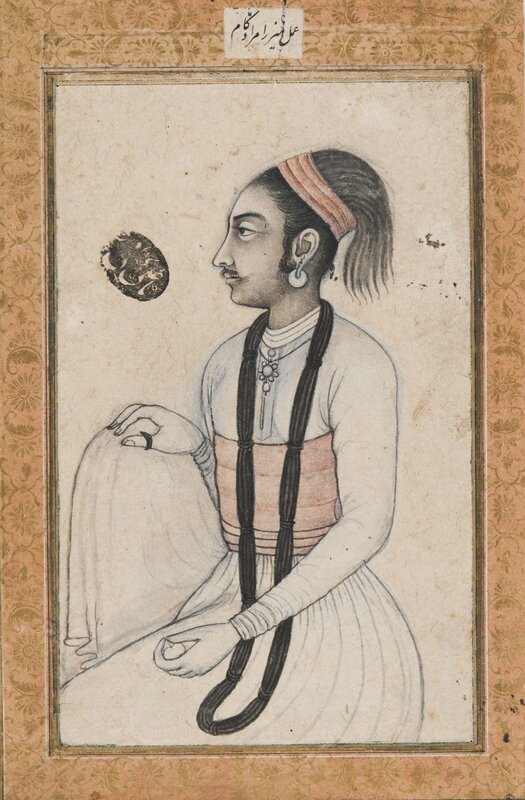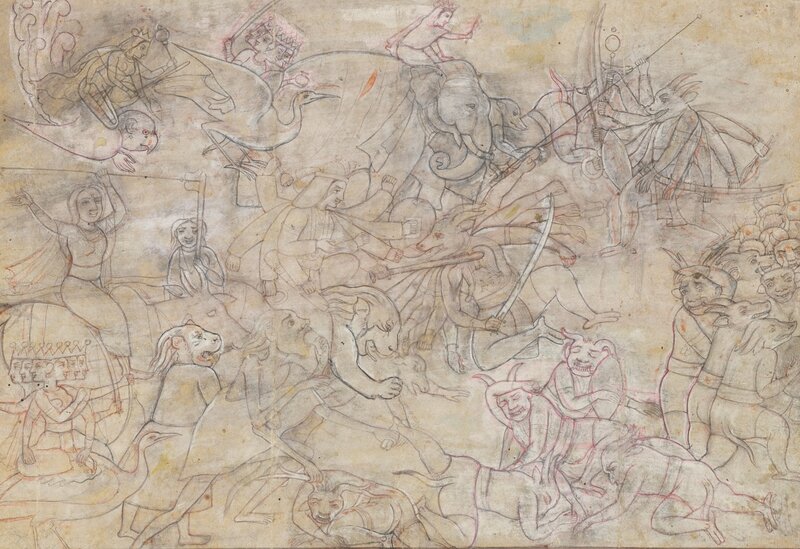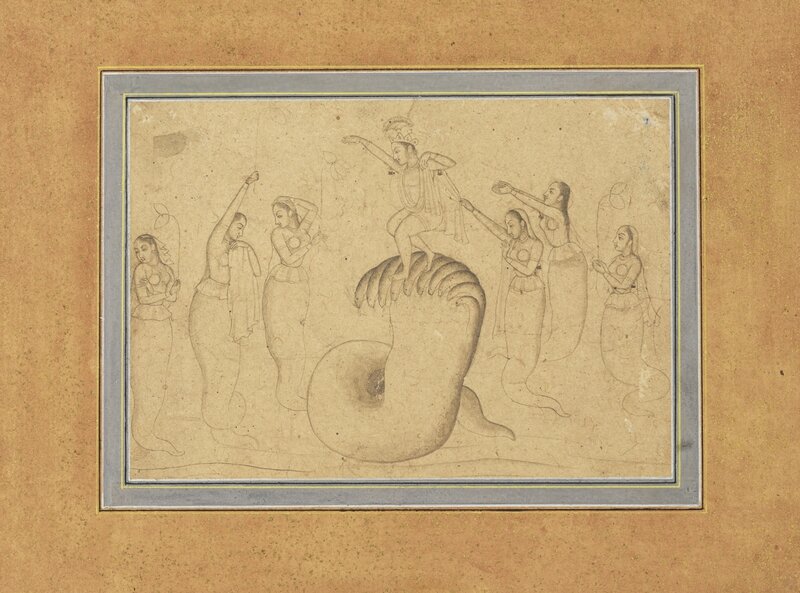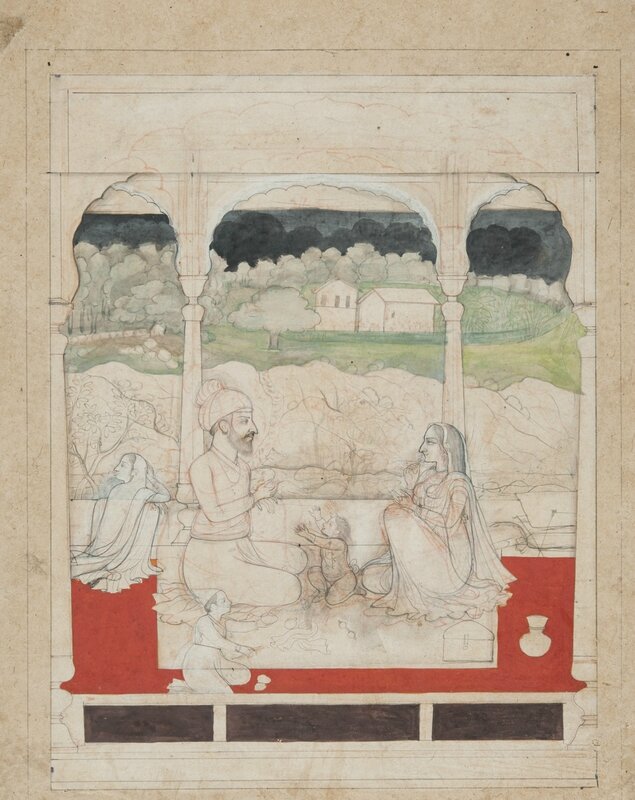"Drawn from Courtly India: The Conley Harris and Howard Truelove Collection" on view in Philadelphia
Two Archers, c. 1710‑1720, India (Rajasthan, Sawar), Brush and black ink, watercolor, and opaque watercolor on beige paper, mounted on paper, Philadelphia Museum of Art, The Conley Harris and Howard Truelove Collection of Indian Drawings, purchased with the Stella Kramrisch Fund for Indian and Himalayan Art, 2013-68-13.
PHILADELPHIA, PA.- The Philadelphia Museum of Art is presenting an exhibition of rare and masterful drawings created in the workshops of royal Indian courts over the course of four centuries. Drawn from Courtly India: The Conley Harris and Howard Truelove Collection features a wide range of sketches, preparatory studies, and compositional drawings that vividly depict mythological themes, verdant landscapes and architectural settings, portraits of prominent rulers, and scenes from the lives of Indian nobility. The Museum acquired these important works in 2013, many as a gift, and is presenting the collection in this exhibition for the first time.
Raj Singh of Sawar with a Standing Courtier, c. 1710‑1720, India (Rajasthan, Sawar), Brush and black ink with white opaque watercolor on beige paper, Philadelphia Museum of Art, The Conley Harris and Howard Truelove Collection of Indian Drawings, 2013-77-18.
While Indian paintings have long been sought after by museums and individual collectors, there has been only a limited interest in drawings. Yet drawings may be wonderful works of art in their own right, yielding a remarkable amount of information about workshop practices and artistic process. Conley Harris, a landscape painter, and the late Howard Truelove, an architectural designer, shared a passion for drawing. They began collecting Indian drawings after being inspired by their travels throughout that country. The collection they assembled over the course of more than a decade provides new insights into the artistic practices of the royal workshops that developed over generations, and offers fresh perspectives on Indian painting. Many of the works to which these collectors were drawn were created during the eighteenth century in the Hindu courts of western India and the Himalayan foothills, an area including the present-day states of Rajasthan, Himachal Pradesh and Jammu-Kashmir.
A Prince and Courtiers in a Garden, c. 1720‑1730, India (Rajasthan, Jodhpur), Brush and brown ink, metallic gold and silver paints, and opaque watercolor over traces of charcoal on beige laid paper, Philadelphia Museum of Art, The Conley Harris and Howard Truelove Collection of Indian Drawings, 2013-77-31.
Timothy Rub, the George D. Widener Director and CEO, stated: “The ongoing development of the Museum’s collection has always represented our partnership with great collectors who have been as passionate as we are about sharing with everyone the finest works of art. In this regard we are especially fortunate to have acquired the marvelous collection assembled by Conley Harris and Howard Truelove, and we are enormously grateful to the collectors. This collection adds a new and important dimension to our holdings of Indian art, which is one of the most important in the country. It also enables us to bring to a broader audience this fascinating and delightful aspect of South Asia’s artistic heritage.”
Portrait of a Seated Ruler Dressed for Ritual Practice, c. 1740, India (Rajasthan, Kishangarh), Brush and black ink and watercolor over charcoal with corrections by the artist in white opaque watercolor on beige laid paper on decorative mount, Philadelphia Museum of Art, The Conley Harris and Howard Truelove Collection of Indian Drawings, 2013-77-25.
The first section of the exhibition features a group of finished drawings and explores the relationship between court artists and their royal patrons. A second focuses on the innovative workshop process, examining how artists developed and revised drawings through techniques such as white wash corrections, color notations, and pouncing. The drawings in this section highlight not only the artists’ adept handling of the medium, they will also testify to the collaboration of artists employed within a hierarchical workshop structure, demonstrating how skills were conveyed from master to apprentice. A third section, dedicated to the key moment when brush first meets paper, calls attention to the expressive power of the expert brushstroke. The fourth and final section of the exhibition invites visitors to respond to the works on display by creating their own drawings using workshop techniques.
Battle Scene with Demons, c. 1740, Attributed to Manaku of Guler, India (Himachal Pradesh, Guler), Brush and black ink over charcoal with pen and red ink ruled line around perimeter on beige paper, Philadelphia Museum of Art, The Conley Harris and Howard Truelove Collection of Indian Drawings, purchased with the Stella Kramrisch Fund for Indian and Himalayan Art, 2013-68-2.
The exhibition is organized by Ainsley M. Cameron, the Museum’s Ira Brind and Stacey Spector Assistant Curator of South Asian Art. She stated: “These works offer new ways of looking and thinking about Indian courtly drawing. People tend to approach the study of paintings or drawings from the perspective of the patron because so many of the artists’ names are unknown, but we are exploring the perspective of the artist, as maker—the gesture of an artist’s hand, the spontaneity of line, and the process through which ideas are born.”
Devi and the Shakti Forces Attack Nishumbha, Shumbha, and Their Army, c. 1760, India (Himachal Pradesh, Guler), Brush and black, red, and orange‑red inks and opaque watercolor over black chalk on beige paper, Philadelphia Museum of Art, The Conley Harris and Howard Truelove Collection of Indian Drawings, purchased with the Stella Kramrisch Fund for Indian and Himalayan Art, 2013-68-8.
Krishna Dancing atop Kaliya, c. 1770-1800, India (Rajasthan, Bikaner), Brush and black ink with touches of red ink over traces of charcoal on beige paper on decorative mount with gold flecks, Philadelphia Museum of Art, The Conley Harris and Howard Truelove Collection of Indian Drawings, 2013-77-23.
Walking Vaishnava Disciples, Late 18th century, India (Rajasthan, Kishangarh), Brush and black ink and watercolor over traces of charcoal on beige laid paper, Philadelphia Museum of Art, The Conley Harris and Howard Truelove Collection of Indian Drawings, 2013-77-5.
The Birth of Krishna, c. 1780, Indian, Brush and black ink over charcoal with touches of blue watercolor on beige laid paper, Philadelphia Museum of Art, The Conley Harris and Howard Truelove Collection of Indian Drawings, purchased with the Stella Kramrisch Fund for Indian and Himalayan Art, 2013-68-17.
Men Falling from Their Rearing Horses, c. 1790, India (Himachal Pradesh, Guler), Brush and black ink over charcoal on beige laid paper, Philadelphia Museum of Art, The Conley Harris and Howard Truelove Collection of Indian Drawings, purchased with the Stella Kramrisch Fund for Indian and Himalayan Art, 2013-68-6.
A Nobleman and His Family in a Pavilion, c. 1790, India (Himachal Pradesh, Kangra), Brush and black and red inks, watercolor, and opaque watercolor with corrections by the artist in white opaque watercolor on beige paper, Philadelphia Museum of Art, The Conley Harris and Howard Truelove Collection of Indian Drawings, purchased with the Stella Kramrisch Fund for Indian and Himalayan Art, 2013-68-14.

/https%3A%2F%2Fprofilepics.canalblog.com%2Fprofilepics%2F1%2F0%2F100183.jpg)
/https%3A%2F%2Fstorage.canalblog.com%2F03%2F02%2F119589%2F96711876_o.jpg)
/https%3A%2F%2Fstorage.canalblog.com%2F11%2F31%2F119589%2F94773502_o.jpg)
/https%3A%2F%2Fstorage.canalblog.com%2F20%2F83%2F119589%2F94772815_o.jpg)
/https%3A%2F%2Fstorage.canalblog.com%2F26%2F72%2F119589%2F75604929_o.jpg)
/https%3A%2F%2Fstorage.canalblog.com%2F59%2F60%2F119589%2F26458628_o.jpg)













/http%3A%2F%2Fstorage.canalblog.com%2F06%2F39%2F119589%2F129007933_o.jpg)
/http%3A%2F%2Fstorage.canalblog.com%2F83%2F41%2F119589%2F128989180_o.jpg)
/http%3A%2F%2Fstorage.canalblog.com%2F65%2F49%2F119589%2F128551133_o.jpg)
/http%3A%2F%2Fstorage.canalblog.com%2F11%2F78%2F119589%2F126903004_o.jpg)